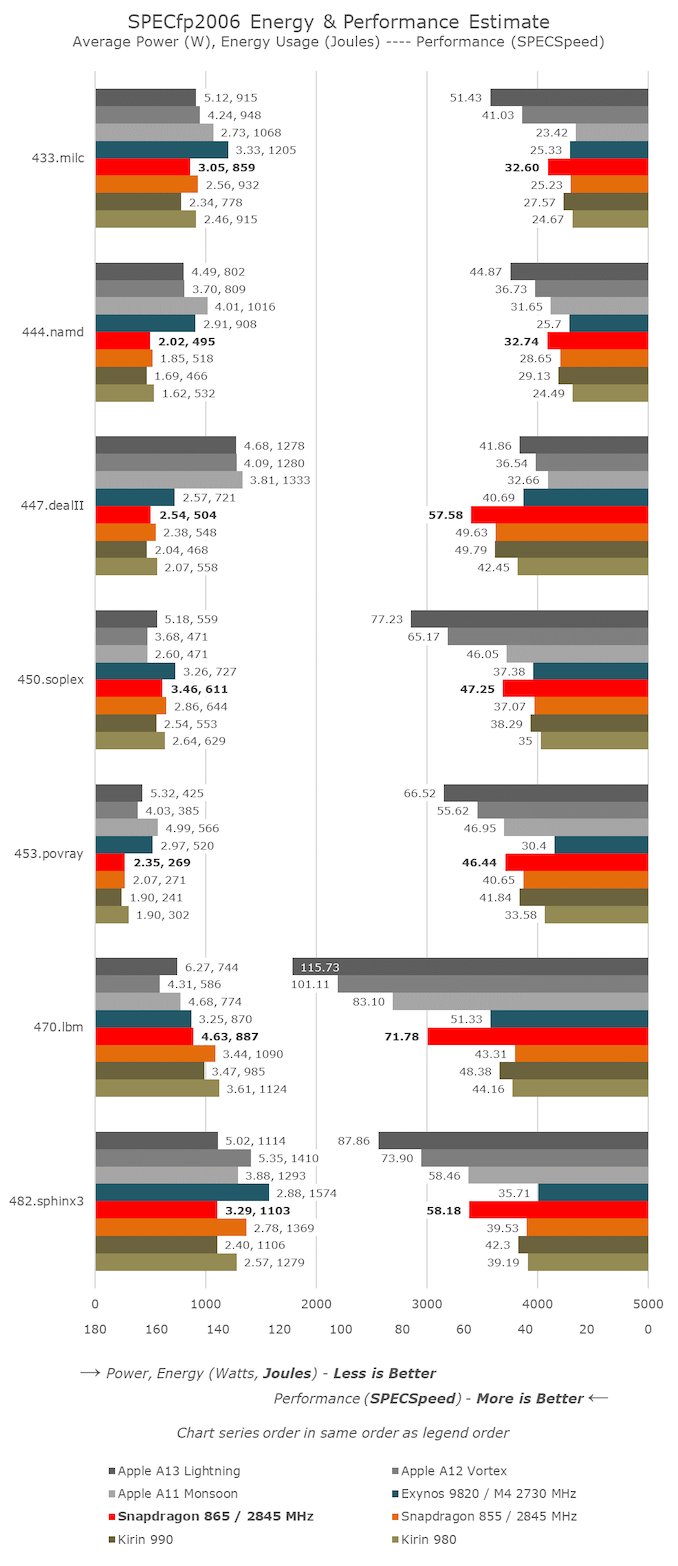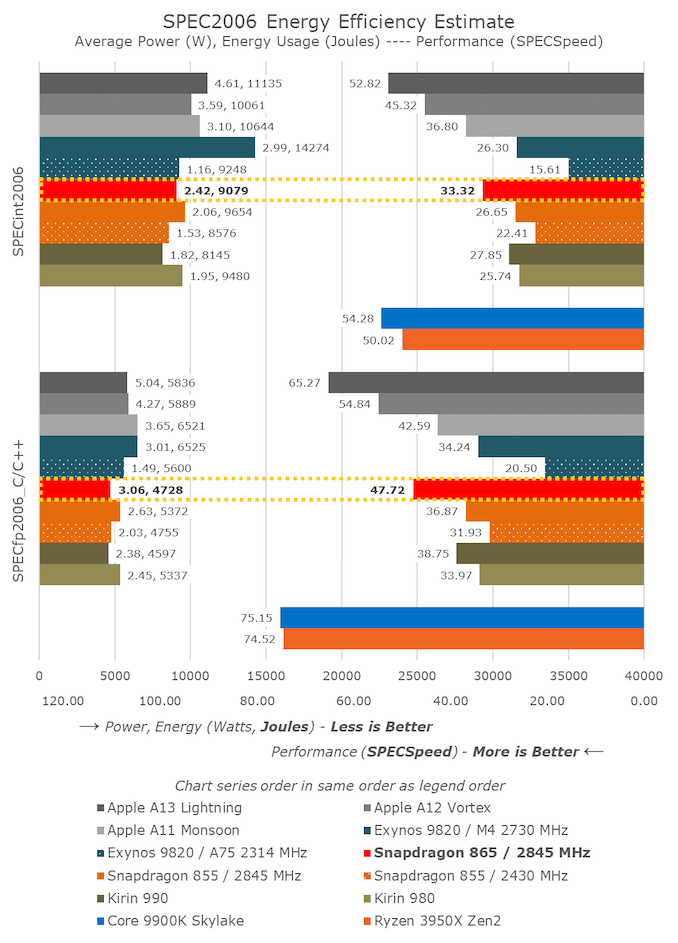The Snapdragon 865 Performance Preview: Setting the Stage for Flagship Android 2020
by Andrei Frumusanu on December 16, 2019 7:30 AM EST- Posted in
- Mobile
- Qualcomm
- Smartphones
- 5G
- Cortex A77
- Snapdragon 865
CPU Performance & Efficiency: SPEC2006
We’re moving on to SPEC2006, analysing the new single-threaded performance of the new Cortex-A77 cores. As the new CPU is running at the same clock as the A76-derived design of the Snapdragon 855, any improvements we’ll be seeing today are likely due to the IPC improvements of the core, the doubled L3 cache, as well as the enhancements to the memory controllers and memory subsystem of the chip.
Disclaimer About Power Figures Today:
The power figures presented today were captured using the same methodology we generally use on commercial devices, however this year we’ve noted a large discrepancy between figures reported by the QRD865’s fuel-gauge and the actual power consumption of the device. Generally, we’ve noted that there’s a discrepancy factor of roughly 3x. We’ve reached out to Qualcomm and they confirmed in a very quick testing that there’s a discrepancy of >2.5x. Furthermore, the QRD865 phones this year again suffered from excessive idle power figures of >1.3W.
I’ve attempted to compensate the data as best I could, however the figures published today are merely preliminary and of lower confidence than usual. For what it’s worth, last year, the QRD855 data was within 5% of the commercial phones’ measurements. We’ll be naturally re-testing everything once we get our hands on final commercial devices.
In the SPECint2006 suite, we’re seeing some noticeable performance improvements across the board, with some benchmarks posting some larger than expected increases. The biggest improvements are seen in the memory intensive workloads. 429.mcf is DRAM latency bound and sees a massive improvement of up to 46% compared to the Snapdragon 855.
What’s interesting to see is that some execution bound benchmarks such as 456.hmmer seeing a 28% upgrade. The A77 has an added 4th ALU which represents a 33% throughput increase in simple integer operations, which I don’t doubt is a major reason for the improvements seen here.
The improvements aren’t across the board, with 400.perlbench in particular seeing even a slight degradation for some reason. 403.gcc also saw a smaller 12% increase – it’s likely these benchmarks are bound by other aspects of the microarchitecture.
The power consumption and energy efficiency, if the numbers are correct, roughly match our expectations of the microarchitecture. Power has gone up with performance, but because of the higher performance and smaller runtime of the workloads, energy usage has remained roughly flat. Actually in several tests it’s actually improved in terms of efficiency when compared to the Snapdragon 855, but we’ll have to wait on commercial devices in order to make some definitive conclusions here.
In the SPECfp2006 suite, we’re seeing also seeing some very varied improvements. The biggest change happened to 470.lbm which has a very big hot loop and is memory bandwidth hungry. I think the A77’s new MOP-cache here would help a lot in regards to the instruction throughput, and the improved memory subsystem makes the massive 65% performance jump possible.
Arm actually had advertised IPC improvements of ~25% and ~35% for the int and FP suite of SPEC2006. On the int side, we’re indeed hitting 25% on the Snapdragon 865, compared to the S855, however on the FP side we’re a bit short as the increase falls in at around 29%. The performance increases here strongly depend on the SoC and particular on the memory subsystem, compared to the Kirin 990’s A76 implementation the increases here are only 20% and 24%, but HiSilicon’s chip also has a stronger memory subsystem which allows it to gain quite more performance over the A76’s in the S855.
The overall results for SPEC2006 are very good for the Snapdragon 865. Performance is exactly where Qualcomm advertised it would land at, and we’re seeing a 25% increase in SPECint2006 and a 29% in SPECfp2006. On the integer side, the A77 still trails Apple’s Monsoon cores in the A11, but the new Arm design now has been able to trounce it in the FP suite. We’re still a bit far away from the microarchitectures catching up to Apple’s latest designs, but if Arm keeps up this 25-30% yearly improvement rate, we should be getting there in a few more iterations.
The power and energy efficiency figures, again, taken with a grain of salt, are also very much in line with expectations. Power has slightly increased with performance this generation, however due to the performance increase, energy efficiency has remained relatively flat, or has even seen a slight improvement.














178 Comments
View All Comments
eastcoast_pete - Monday, December 16, 2019 - link
Thanks Andrei! Amy chance to post the S855's QRD's figures also? These QRDs are "for example" demo units, and the final commercial handsets are often different (faster). Also, any word from QC on how much AI processing power will be needed to run 5G functionality? Huawei's Kirin 990 5G has twice the AI TOPs than their LTE version, and that seems to be due to their (integrated) 5G modem using about half the AI TOPs when actually working in 5G modeeastcoast_pete - Monday, December 16, 2019 - link
Any chance, of course. Edit function would be nice.Andrei Frumusanu - Monday, December 16, 2019 - link
I don't see the point in showing the QRD855 results, there's a large spectrum of S855 device results out there and likely we'll see the same with the S865. The QRD855 and QRD865 aren't exactly apples-to-apples configuration comparisons either so that comparison doesn't add any value.ChitoManure - Monday, December 16, 2019 - link
Because QRDs from qualcomm might have the simikar cooling system and the OEMs usually have better thermal design which is why they are faster..Andrei Frumusanu - Monday, December 16, 2019 - link
None of the tests were made under thermal stress scenarios, the cooling isn't a limitation on the QRDs, the performance showcased is the best the chip can achieve.Kishoreshack - Monday, December 16, 2019 - link
Man the web benchmarks are DISAPPOINTINGfeel like buying a S10+ now
Kishoreshack - Monday, December 16, 2019 - link
Just shows how Samsung does the best implementation of Qualcomm Soc'seven last years Samsung 855 devices are able to out perform Snapdragon 865 in many benchmarks
Can't wait for S11 now
Kishoreshack - Monday, December 16, 2019 - link
Anyone even expected Qualcomm beating Apple in performance?You were dreaming then
don't know whom to blame Arm or Qualcomm
but the Android world is constantly receiving inferior chips
Karmena - Monday, December 16, 2019 - link
IMHO all these SOCs are at the level that average Joe can do with any of these and the device will feel snappy and good. Now it comes down to the OS delivering the performance and features that users crave.doungmli - Monday, December 16, 2019 - link
the only benchmarks are the web, 3dmark and geekbench for the a13 chip the rest is in favor of the snapdragon. It should perhaps be remembered that this is a soc so cpu + isp + gpu + ... and when adding the snapdragon >>>> A13. just see the AI markers which take into account the entire soc. For gfx bench it would be necessary to explain why so much difference whereas in the other benchmarks GPU there is not this difference but gfx bench is not outdated for more than a year for me it is no longer a reference. For web performance just see the speed tests on youtube to see that this score is not justified